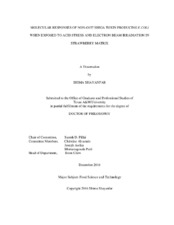| dc.contributor.advisor | Pillai, Suresh D | |
| dc.creator | Shayanfar, Shima | |
| dc.date.accessioned | 2017-03-02T16:47:45Z | |
| dc.date.available | 2018-12-01T07:20:04Z | |
| dc.date.created | 2016-12 | |
| dc.date.issued | 2016-12-07 | |
| dc.date.submitted | December 2016 | |
| dc.identifier.uri | https://hdl.handle.net/1969.1/159017 | |
| dc.description.abstract | Non-O157 Shiga toxin producing E.coli (STEC) serogroups are responsible for a growing number of food-related illnesses around the world. These serogroups experience dramatic pH fluctuations either by organic acids introduced during food processing or by inorganic acids in the stomach, which induce acid resistance in the pathogens. The main non-O157 STEC serogroups were analyzed for their acid sensitivity by exposing them to acid buffer, inorganic acid buffer and strawberry puree for 24h and room temperature. The results show that bacterial inactivation depends on the nature of the acid and the strain (P<0.01). Each of the serogroups exhibits different levels of resistance to acid stress with O103 as the most resistant strain and O26 and O111 as the weakest of all to acid stress (P<0.01). The pattern of microbial inactivation of the acids is inorganic acid> strawberry > organic acid. An untargeted metabolomics analysis identified that peptidoglycan, nitrogen, and unsaturated fatty acid biosynthesis are activated in E.coli O26 when exposed to inorganic acid buffer, to protect the structural integrity of the cells. D-Glutamine/D-glutamate metabolism was activated in both strawberry puree and inorganic acid exposed cells to possibly maintain the homeostasis of the cellular pH. Application of 1kGy of eBeam results in a 4-log inactivation of a cocktail of non-O157 STEC serogroups in strawberry puree and a significant (>99.99%) reduction in public health risks. A lethal dose of 3 kGy of eBeam activated metabolic pathways related to DNA repair, virulence and glutathione metabolism in an attempt to repair the lethal damage. Transcriptomic analysis results indicate that when E.coli O26 cells are maintained for 24 hours in phosphate buffered saline (PBS) buffer 88% (5358 genes) of its 6089 genes were up-regulated. However, in the cells are stored at room temperature in a strawberry matrix, only 71 genes (1.1%) were up-regulated. When E.coli O26 cells were exposed to 3 kGy eBeam dose and stored in PBS buffer and strawberry matrix, 5379 and 2250 genes were upregulated respectively. Though the cells are inactivated after exposure to lethal doses of eBeam radiation, the metabolomic and transcriptomic analysis indicate that they are still metabolically active. | en |
| dc.format.mimetype | application/pdf | |
| dc.language.iso | en | |
| dc.subject | STEC | en |
| dc.subject | Strawberries | en |
| dc.subject | Electron Beam | en |
| dc.subject | Food Safety | en |
| dc.subject | Metabolomics | en |
| dc.subject | Transciptomics | en |
| dc.subject | QMRA | en |
| dc.title | Molecular Responses of Non-O157 Shiga Toxin Producing E.coli When Exposed to Acid Stress and Electron Beam Irradiation in Strawberry Matrix | en |
| dc.type | Thesis | en |
| thesis.degree.department | Nutrition and Food Science | en |
| thesis.degree.discipline | Food Science and Technology | en |
| thesis.degree.grantor | Texas A & M University | en |
| thesis.degree.name | Doctor of Philosophy | en |
| thesis.degree.level | Doctoral | en |
| dc.contributor.committeeMember | Alvarado, Christine | |
| dc.contributor.committeeMember | Awika, Joseph | |
| dc.contributor.committeeMember | Patil, Bhimanagouda | |
| dc.type.material | text | en |
| dc.date.updated | 2017-03-02T16:47:45Z | |
| local.embargo.terms | 2018-12-01 | |
| local.etdauthor.orcid | 0000-0002-7869-9822 | |


